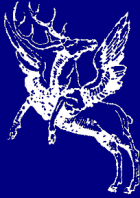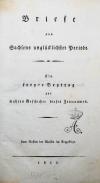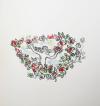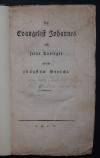Gesamtbestand
Die Liste enthält 5006 Einträge. Es ist kein Suchergebnis aktiv, der gesamte Bestand wird angezeigt.
| Abbildung |
Beschreibung Gesamte Buchaufnahme |
Preis EUR |
|
|---|---|---|---|
| Renger-Patsch, Albert. Gestein. Photographien typischer Beispiele von Gesteinen aus europäischen Ländern. Mit einer Einführung und Bildtexten von Max Richter und mit einem Essay von Ernst Jünger. Ingelheim am Rhein, C. H. Boehringer Sohn 1966. 4°. 33 (1) S. mit 62 Tafeln. OLn.
Heidtmann 14391. Koetzle 361 f. W.-G.² 106. – Erste und einzige Ausgabe. – Schönes Exemplar. Schlagwörter: Gestein |
70,-- |  |
|
| Newton, Isaac. Optice, sive de reflexionibus, refractionibus, inflexionibus et coloribus lucis lirbi tres. Latine reddidit Samuel Clarke. Editio novissima. Lausanne & Genevae, Bousquet & Sociorum 1740. 4° (25 x 20 cm.). XXXII, 363, (1) S. mit Titel in Rot u. Schwarz, gestoch. Titelvignette, gestoch. Frontispiz (Portrait), figürl. Initialen u. 12 gefalt. Kupfertafeln. Prgt. d. Zt. mit goldgepr. Rückenschild.
Babson 141. Gray 182. VD18 11360216. Wallis 182. Vgl. PMM 172 (engl. Originalausgabe von 1704). – Dritte und zweite lateinische Ausgabe. – Mit einer gedruckten Widmung an Johannes Bernoulli. – „This is one of the great classics of optics. It. expounds Newton’s corpuscular or emission theory of light, and first contains his important optical discoveries in a collected form. It also gives two important mathematical treatises left out in the later ones. especially with a view to assert Newton’s rights to the discovery of the calculus (about which the controversy with Leibnitz was then just preparing). The last passage of the Advertisment is of importance in connexion with the Newton-Leibnitz controversy. The phenomenon of the rainbow, first propounded by De Dominis in 1611, and later by Descartes, is here fully explained, as well as ’Newton’s Rings’ and other optical matters. ’Newton’s ‚Optics‘ did for light what his ‚Principia‘ had done for gravitation, namely, placed it on a scientific basis.’ – Prof. E. W. Brown, of Yale University“ (G. K. Babson). – Isaac Newton begann sein Studium des Lichtes und der wissenschaftlichen Optik in Cambridge, als er noch nicht promoviert war, und setzte es zu Hause in Lincolishir während der Pestjahre 1665-66 fort, als er, wie er sich erinnerte, »in der Schaffensblüte seines Lebens stand«. Damals wie heute wurde das Verhalten von Licht experimentell und mathematisch untersucht; Newton nahm beide Mittel zu Hilfe, doch der Kern seiner Arbeit war die Beobachtung, daß sich das Farbenspektrum – bei Durchgang eines Lichtstrahls durch ein Glasprisma erzeugt – entlang seiner Achse ausbreitete, zusammen mit dem experimentellen Beweis, daß Strahlen unterschiedlicher Farben verschieden stark gebrochen wurden, was die Bandbreite oder Dispersion des Spektrums verursacht. Alle früheren Philosophen und Mathematiker waren sich sicher daß weißes Licht rein und einheitlich ist. Sie betrachten Farben als Modifikationen oder Trübungen von Weiß. Newton zeigt experimentell, daß das Gegenteil der Fall ist: es gibt reine Farbstrahlen, die durch Brechung nicht zerlegt werden können wie das Grün des Spektrums; genauso gibt es Farbstrahlen die zerlegt werden können, wie das Grün, das aus der Mischung von blauem und gelbem Licht entsteht. Natürliches weißes Licht ist weit davon entfernt, einheitlich zu sein, viel mehr ist es aus vielen reinen Elementarfarben zusammengesetzt, die nach Belieben getrennt und wieder vereinigt werden können. … Newtons >Optik<; ist auch unter zwei anderen Gesichtspunkten bemerkenswert die erste Auflage brachte Newtons erste mathematischen Aufsätze im Druck – der Streit mit Leibniz hatte schon begonnen – und in den späteren Auflagen wurde das Werk durch eine Sammlung von >Fragen<; bereichert von denen man lange Zeit annahm, sie stellten Newtons Meinungen zu den wichtigsten Naturgeheimnissen dar“ (Carter/Muir). – Einband etwas angestaubt, Exlibris, stellenweise etwas gebräunt, gutes Exemplar. Schlagwörter: Optics, Optik, Physics, Physik |
2.800,-- |  |
|
| Ortelius, Abraham. Aurei saeculi imago, sive Germanorvm vetervm vita, mores, ritus, & religio. Iconibus delineata, & commentariis ex utriusque linguae auctoribus descripta. Antverpiae Advaticorum (Antwerpen), (J. Moretus für) Philipp Galle 1596. Gr.-8° (24 x 17 cm.). [14] Bl. mit Druckermarke und 10 ovalen Kupferstichen von Philipp Galle nach Peter van der Borcht. Späterer Prgt. mit goldgepr. Rückenschild.
ADB XXIV, 428 ff. BM, STC German 162. Funck 374. Imhof, Moretus O-73. New Holstein, P. van der Borcht V, 2349-2358. Nicht bei Adams. – Erste Ausgabe des seltensten Werks von Ortelius. – „Série de dix jolies vignettes de van der Borcht. C’est le plus rare de tous les ouvrages d’Ortelius“ (Funck). Laut Vermerk in der Approbatio sind die Kupfer, die teils recht drastische Szenen aus dem Leben der Germanen zeigen, von Ph. Galle gestochen. – „(E)in mit 16 Stichen nach Galläus geschmückter kurzer Commentar zu den alten Schriftstellern über Deutschland“ (F. Ratzel in ADB). – Der bedeutende Geograph, Archäologe und Historiker A. Ortelius (eig. Oertel oder Ortels, 1527-1598), dessen Großvater aus Augsburg nach Belgien emigriert war; sein Hauptwerk der „Thesaurus Orbis Terrarum“ ist der erste große Atlas des 16. Jahrhunderts und seine umfangreiche Kartensammlung gehört zu den werthvollen Quellen der Geschichte der Kartographie im 16. Jahrhundert. – First edition of the rarest book of Ortelius. It sketches the ancient history of the Germans illustrated with 10 vignettes engraved by Ph. Galle after Peter van der Borcht. – Einband etwas gewellt und leicht fleckig, durchgängiger Wurmgang in der oberen Innenecke hinterlegt (bei den meisten Kupfern bis in den Plattenrand, jedoch ohne Bild- und Textverlust), stellenweise leicht gebräunt und fleckig, gutes Exemplar. – Light browning resp. spotting, restored worm track to upper inner corner throughout (without loss of image or text). Later vellum, slightly stained, waved, otherwise well preserved copy. Schlagwörter: Antike, Emblemata, Germanen, Germanien, Illustrated books, Illustrierte Bücher, Mythologie, Mythology, Soziologie, Volkskunde |
2.400,-- |  |
|
| Einband – Weinroter Maroquin-Ledereinband mit dekorativer Rückenvergoldung, Goldgepr. Deckelfiletten, Feurons in den Ecken, Wappen-Supralibros (Louis XV., König von Frankreich), Kanten- und Innenkantenvergoldung und Goldschnitt sowie Goldbrokat-Vorsätzen. Inhalt: Almanach royal, année MDCCXVIII. Paris, Laurent d’Houry (1717). 8° (19,5 x 12,5 cm.). 346 S., [2] Bl. mit Titelvignette in Holzschnitt u. 2 Holzschnitten (Sonnen-Finsternis) im Text.
Prachtvoller Barock-Einband aus der Bibliothek von Ludwig XV., König von Frankreich (1710-1774). – Der von Laurent d’Houry seit 1683 herausgegebene Almanach des franz. Adels erschien bis 1792 mit dem Titel „Almanach royal“ danach bis 1919 mit verschiedenen Titeln (″Annuaire impérial“ u. a.). – Louis XV wurde vom „Volk „der Vielgeliebte“ (französisch le Bien-Aimé) und später „der Ungeliebte“ (französisch le Mal-Aimé) genannt. Unter seiner Regierung wurde der jahrhundertealte Gegensatz zwischen Frankreich und Österreich beigelegt und die neue Allianz durch die Heirat Marie-Antoinettes, der Tochter Maria Theresias von Österreich, mit seinem Enkel, dem späteren Ludwig XVI., besiegelt. Bekannt ist seine Beziehung zu seiner Mätresse Marquise de Pompadour. Nach ihm ist die Stilepoche Louis-quinze benannt“ (Wikipedia). – Nur vereinzelt etwas gebräunt und fleckig, sehr gut erhalten. – Reliure aux armes de France Louis XV. Schlagwörter: Almanache, Taschenbücher, Kalender, Almanacs, Einbände, Frankreich, Geschichte |
1.600,-- |  |
|
| Strutt, Joseph. The Sports and pastimes of the people of England. Including the rural and domestic recreations, May games, mummeries, shows, processions, pageants & pompous spectacles, from the earliest period to the present time. Illustrated by one hundred and forty engravings. In which are represented most of the popular diversions; selected from ancient paintings. A New Edition, with a copious index, by William Hone. London, Thomas Tegg 1845. Gr.-8°. LXVII, 420 S. mit 136 Holzschnitten im Text. Olivgrüner Maroquin-Lederband der Zeit mit goldgepr. Rückenschild, reicher Rücken- und Deckelvergoldung, Innenkantenvergoldung und Goldschnitt (signiert Seton, Edinburgh).
Hiler 820. Lipperheide Gca 15 u. 16. Lowndes 2533. – Vierte Ausgabe. – Prachtvoll gebundenes Exemplar auf Velin. – Beschrieben und illustriert werden u. a. Falknerei, Jagd, Pferderennen, Turniere, Mummenschanz, Gaukler, Tanz, Ballspiele, aber auch Karten- und Würfelspiele, Backgammon, Schach usw. – In einem prächtigen Einband des bedeutenden schottischen Buchbinders Robert Seton II. (1806-1854), seit 1833 Buchbinder von König William IV. – Vorderes Gelenk spröde und etwas angeplatzt, Rücken und Kanten etwas berieben, 3 Exlibris, sonst gut erhalten. Schlagwörter: Einbände, England, Grossbritannien, Kulturgeschichte, Soziologie, Spiele, Sport |
200,-- |  |
|
| Genlis, (Stéphanie Félicité) de. Mademoiselle de Clermont. Nouvelle historique. Paris, Maradan 1813. 12° (13 x 7,5 cm.). [2] Bl., 198 S. mit gestoch. Portrait und 4 Kupfertafeln von Adrian Godefroy nach Alexandre Desenne. Schwarzer Maroquin-Lederband mit dekorativer Rückenvergoldung, goldgepr. Deckelfiletten, Kanten- und Innenkantenvergoldung und Goldschnitt (signiert: „R(éne) P. Simier fils“
LKJ II, 436 ff. – Erste illustrierte Ausgabe; erschien zuerst 1802. – Die nahezu hundert Titel zählende literarische Produktion der Mme de G. umfaßt Werke verschiedener Gattungen. Unter ihen romanhaften Erzählungen mit oft historischen Stoffen gilt „Mademoiselle de Clermont“ (1801) als die gelungendste“ (T. Brüggemann in LKJ). – Außergewöhnlich schönes Exemplar in einem prachtvollen Handeinband des französischen Buchbinders René Simier (1772-1843), der neben Jean-Georges Purgold und Joseph Thouvenin zu den bedeutendsten französischen Buchbindern des 19. Jahrhunderts zählt. – Goldgepr. Leder-Exlibris (″Georges Wendling“), stellenweise etwas braunfleckig, sonst sehr gut erhalten. Schlagwörter: Einbände, Französische Kinderbücher, Illustrated books, Illustrierte Bücher |
600,-- |  |
|
| Kahn, Gustave. Das Weib in der Karikatur Frankreichs. Mit 448 Textillustr. und 72 farbigen Kunstblättern nach seltenen und amüsanten französischen Karikaturen aus allen Zeitepochen. 1. – 10. Tsd. Stuttgart, Hermann Schmidt 1907. 4°. VII, 472 S. 72 Farbtafeln und 448 Abb. im Text. Farbig illustr. OLn.
Hayn-Gotendorf II, 391. – Erste Ausgabe. – „Ein sehr amüsantes Supplement zu Fuchs’ Karikaturenwerken“ (Hayn-Gotendorf). – Sehr gutes Exemplar. Schlagwörter: Frankreich, Frau, Karikatur |
70,-- |  |
|
| Baudelaire, Charles. Les fleurs du mal. Portrait gravé par A(guste Louis) Brouet. Paris, Gilbert Lély 1931. 8°. X, 310 S. mit 1 Orig.-Radierung von A. Brouet. OKart.
Eines von 1275 num. Exemplaren auf Papier Vergé à la Cuve (GA 1303 Exemplare). – Schöner Druck in Rot und Schwarz von R. Coulouma mit dem bekannten Portrait des franz. Radierers und Kupferstechers Auguste Louis Brouet (1872-1941). – Gutes Exemplar. Schlagwörter: Nummerierte Bücher |
40,-- |  |
|
| Cazotte, Jacques. Der Liebesteufel. Mit Wiedergabe der Kupfer von Moreau Le Jeune & Marillier. (Mit einem Nachwort von Curt Moreck). München, G. E. Sanders 1922. 8°. 94 S. mit Frontispiz und 6 Tafeln nach Kupferstichen. OHldr. mit goldgepr. Rückenschild und dezenter Rückenvergoldung.
Schönes sauberes Exemplar. Schlagwörter: Erotica, Illustrated books, Illustrierte Bücher |
40,-- |  |
|
| Juritz, Sascha. Bekenntnisse. Verse zu Originalgrafiken von Sascha Juritz. Frankfurt am Main, Verlag Dieter Strametz 1989. Gr.-8°. [16] Bl. mit 13 signierte und nummerierte Orig.-Farblithographien. Farbig illustr. OPbd.
Nr. 2 von 150 num. Exemplaren; im Druckvermerk von S. Juritz und alle Lithographien signiert. – Mit Gedichten von B. Brecht, G. B. Fuchs, J. Haringer, P. Scheerbart, V. v. Törne u. a. – S. Juritz (1939-2003) war seit 1962 Professor an der Hochschule für Gestaltung in Offenbach am Main. Juritz war Zeichner, Maler, Graphiker, Bildhauer, Steindrucker und Verleger. – Sehr gutes Exemplar. Schlagwörter: Illustrated books, Illustrierte Bücher, Nummerierte Bücher, Signierte Bücher, Signierte Künstler-Graphik |
140,-- |  |
|
| (Longus). Daphnis & Chloe. Translated out of the Greek of Longus by George Thornley in 1657. With decorations by John (Archibald) Austen. London, Geoffrey Bles 1925. 4°. 199, (1) S. mit 16 farblithogr. Tafeln. OLn. mit goldgepr. Rückentitel und Deckelvignette.
Erste Ausgabe mit diesen Illustrationen. – Luxuriöser Druck auf kräftiges Büttenpapier mit hervorragenden Art Deco-Illustrationen des britischen Buchkünstlers J. A. Austen (1886-1948). Austen war auch als Werbegraphiker und Plakatkünstler tätig. – Sehr schönes sauberes Exemplar. Schlagwörter: Art Déco, Erotica, Illustrated books, Illustrierte Bücher |
240,-- |  |
|
| Régnier, (Mathurin). Satyres et autres oeuvres de Regnier. Accompagnées de remarques historiques. Nouvelle edition considerablement augmentée. Londres (i.e. Amsterdam), Jacob Tonson 1733. 4° (28 x 23,5 cm.). XX,420 S. mit Titel in Rot u. Schwarz, gestoch. Frontispiz von L. Cars nach C. Natoire, gestoch. Titelvignette von Nicolas Cochin und 21 (teils wdh.) Kopf- und Schlußvignetten von Cochin nach Boucher und Natoire sowie 1 gestoch. Portrait von St.-Aubin. Kalbslederband der Zeit. mit goldgepr. Rückenschild, reicher floraler Rückenvergoldung und Innenkantenvergoldung.
Brunet IV, 1188. Cioranescu 19048. Cohen-Ricci 867. Graesse VI, 67. Sander 1684. Tchemerzine IX, 392. – Prachtvoll ausgestattete Ausgabe; jede Seite mit roter Bordüre. – Mit historischen Anmerkungen von Claude Brossette und Lenglet-Dufresnoy. – Der franz. Satiriker M. Régnier (1573-1613), Neffe des Dichters Philippe Desportes, wurde 1609 zum Domherrn von Chartres ernannt. „Seine sechzehn Satiren, die das alltägliche Leben und typische Figuren seiner Zeit behandeln, sind im Stil von Horaz und Juvenal verfasst. Die Sprache ist volkstümlich und farbenreich. Als sein bedeutendstes Werk gilt die Satire Macette“ (Wikipedia). – Einband etwas berieben, vorderes Gelenk unten etwas angeplatzt, stellenweise wasserfleckig und teils stärker gebräunt, insgesamt gutes dekorativ gebundenes Exemplar. Schlagwörter: Illustrated books, Illustrierte Bücher, Satire, French |
280,-- |  |
|
| Régnier, (Mathurin). Satyres et autres oeuvres de Regnier. Accompagnées de remarques historiques. Nouvelle edition considerablement augmentée. Londres (i.e. Amsterdam), Jacob Tonson 1733. 4° (28 x 23,5 cm.). XX,420 S. mit Titel in Rot u. Schwarz, gestoch. Frontispiz von L. Cars nach C. Natoire, gestoch. Titelvignette von Nicolas Cochin und 21 (teils wdh.) Kopf- und Schlußvignetten von Cochin nach Boucher und Natoire sowie 1 gestoch. Portrait von St.-Aubin. Kalbslederband der Zeit. mit goldgepr. Rückenschild, reicher floraler Rückenvergoldung, Deckelfiletten und Innenkantenvergoldung.
Brunet IV, 1188. Cioranescu 19048. Cohen-Ricci 867. Graesse VI, 67. Sander 1684. Tchemerzine IX, 392. – Prachtvoll ausgestattete Ausgabe; jede Seite mit roter Bordüre. – Mit historischen Anmerkungen von Claude Brossette und Lenglet-Dufresnoy. – Der franz. Satiriker M. Régnier (1573-1613), Neffe des Dichters Philippe Desportes, wurde 1609 zum Domherrn von Chartres ernannt. „Seine sechzehn Satiren, die das alltägliche Leben und typische Figuren seiner Zeit behandeln, sind im Stil von Horaz und Juvenal verfasst. Die Sprache ist volkstümlich und farbenreich. Als sein bedeutendstes Werk gilt die Satire Macette“ (Wikipedia). – Einband etwas berieben, Kapital restauriert, Gelenke spröde und stellenweise angeplatzt, Wappen-Exlibris, stellenweise teils stärker gebräunt, noch gutes dekorativ gebundenes Exemplar. Schlagwörter: Illustrated books, Illustrierte Bücher, Satire, French |
240,-- |  |
|
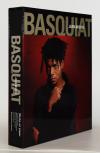 |
Basquiat – Blistene, Bernard u. a. Jean-Michel Basquiat. Works on paper. (Preface by Enrico Navarra, essays by B. Blistène, Elena Ochoa, Robert Farris Thompson and Richard D. Marshall). Paris, Galerie Enrico Navarra (1999). 1997. 375, (1) S. mit zahlr. farb. Abb. Farbig illustr. OPbd. mit farbig illustr. Orig.-Pappschuber.
Erste und einzige Ausgabe. – Tadellos. Schlagwörter: Catalogue raisonné, Catalogues raisonnés, Painting, American, Werkverzeichnis, Werkverzeichnisse |
3.200,-- |  |
 |
Streich, Tr(augott) Fr(iedrich) u. K(arl) v. Gerstenberg. Arbeitsstätten und Werkzeuge der wichtigsten Handwerker. Mit erläuterndem und geschichtlichem Text versehen. 2. Aufl. Esslingen und München, Schreiber o. J. (1885). 4°. (2) Bl., 13 S. u. 24 farblithogr. doppelblattgr. Tafeln. OHln. mit Deckelschild u. typogr. Orig.-Schutzumschlag.
Slg. Breitschwerdt 259. Klotz 1874/1, Klotz, Bilderbücher 5710/1. Wegehaupt IV, 2185. – Seltenes Anschauungs-Bilderbuch mit Werkstattszenen und Darstellung verschiedener Werkzeuge. Eines der schönsten Werke mit Berufsdarstellungen überhaupt. „Gegenüber der Erstausgabe von 1875 ist hier das Vorwort nicht dabei und der beschreibende Text ist neu gefaßt und wesentlich kürzer gehalten“ (W. Geisenheyner). – Die prachtvollen figurenreichen Tafeln zeigen Werkstätten der Schneider, Bäcker, Metzger, Gerber, Schuhmacher, Sattler, Schreiner, Wagner, Küfer, Bauhandwerker, Schlosser und Buchbinder, darunter die Berufsbezeichnungen deutsch und französisch. Danach jeweils Tafeln mit Darstellung der Werkzeuge. Die Werkstatt-Szenen zeigen jeweils das ganze Spektrum der Aufgaben und Tätigkeiten, so daß z. B. Arbeiten für den Kutschenbau nicht nur beim Wagner, sondern auch beim Sattler gezeigt werden. – Das Bilderbuch erschien zuerst 1875 in der Reihe „Schreiber’s Bilder zum Anschauungs-Unterricht“. – Schutzumschlag mit geringen Randläsuren und kl. Fehlstelle am Fuß, eine Tafel mit rest. Einriss im w. Rand, sehr gutes sauberes Exemplar. Schlagwörter: Anschauungsbücher, Berufe, Handwerk |
1.400,-- |  |
 |
Osten, Gert von der u. Horst Keller (Hrsg.). Kunst der sechziger Jahre. Sammlung Ludwig im Wallraf-Richartz-Museum, Köln. Bearbeitung und Organisation: Evelyn Weiss u. Rainer Budde. Visualisation: Wolf Vostell. Beratung und konservatorische Betreuung: Wolfgang Hahn. Fotograf. Arbeiten: Ann Munchow. 5., erweiterte Aufl. Köln, Wallraf-Richartz-Museum (1971). 4°. [74] S., 242 S. mit zahlr. teils farb. Abb., teils eingeklebt, teils auf Folienblätter gedruckt. Original-Klarssichtkunststoffumschlag mit Metallschrauben-Heftung u. Plexiglas-Rücken.
Maßgebliche Ausgabe des aufwändigen Katalogs der berühmten Sammlung Ludwig, die 1968 als Leihgabe an das Kölner Wallraf-Richartz-Museum übergeben wurde. – Vom Inhalt der legendären Sammlung, aber auch in der haptischen Gestaltung (Folienordner, Druck auf Silber- und Packpapier, Folien und »Schaumstoff«-Blätter), bis heute unübertroffene Dokumentation zu 92 Künstlern mit 209 auf Farbtafeln vorgestellten Kunstwerken. -Katalogausstattung und Einbandgestaltung von W. Vostell. – Sehr gutes Exemplar. Schlagwörter: Pop-art |
200,-- |  |
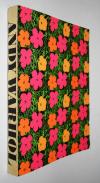 |
Warhol – Andy Warhol. (Publication on the occasion of the Andy Warhol Exhibition at Moderna Museet in Stockholm, February-March 1968). Third edition. Boston, Massachusetts, Boston Book and Art Publisher (1970). Gr.-8°. [327] Bl. mit über 300 meist ganzs. Abb. nach Photographien von Rudolph Burckhardt, Eric Pollitzer und John D. Schiff. Farbig illustr. OKart.
Crone 81. Koetzle 479 f. Parr/Badger II, 144 f. The Open Book 238 f. – Amerikanische Ausgabe. – Von Andy Warhol, Kaspar König, Pontus Hultén und Olle Granath herausgegeben. – „The Moderna Museet book is a worthy adjunct to Index (Book), an exhibition catalogue that transcends any limitations that might be suggested by this genre. It is a fine example of the catalogue-as-artist’s-book, a form that ostensibly began with the Dadaists and Surrealists, and is produced with some of the roughest reproductions ever seenm which are entirely appropriate, and supplemented by a long sections of Factory snapshots again by Billy Name. The genre was revitalized by the Pop movement, and Warhol in particular, which demonstrates his position as a latter-day Dadaist. If you could only have one Warhol-inspired photobook, the Index must rank first, but the Moderna Museet book is close behind“ (Parr/Badger). – „Die Fotografie und das Fotografieren bilden das Zentrum des Werks von Andy Warhol“ (U. M. Schneede in Koetzle). – Papierbedingt wie immer gebräunt, sehr gutes Exemplar. Schlagwörter: Pop art, Pop-Kultur |
350,-- |  |
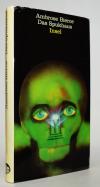 |
Bierce, Ambrose. Das Spukhaus. Gespenstergeschichten. Frankfurt a. M., Insel 1969. Gr.-8°. 173 S. OPbd. mit farb. illustr. OU.
Erste Ausgabe. – Umschlag an Kapital u. Kanten etwas berieben, E. a. V. u. N. a. T., gutes Exemplar. Schlagwörter: Fantasie, Fantastik, Phantasie, Phantastik / Utopie |
30,-- |  |
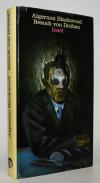 |
Blackwood, Algernon. Besuch von Drüben. Gruselgeschichten. Frankfurt am Main, Insel-Verlag 1970. Gr.-8°. 259 S. OPbd. mit farb. illustr. OU. (Bibliothek des Hauses Usher).
Erste Ausgabe. – Umschlag leicht gebräunt, an den Kanten etwas berieben u. mit 1 kl. Randläsur, N. a. V. gutes Exemplar. Schlagwörter: Fantasy, Phantasie, Phantastik / Utopie |
30,-- |  |
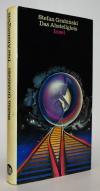 |
Grabinski, Stefan. Das Abstellgleis. Unheimliche Geschichten. 1. Aufl. Frankfurt am Main, Insel-Verlag 1971. Gr.-8°. 213 S. OPbd. mit farb. illustr. OU. (Bibliothek des Hauses Usher).
Erste Ausgabe. – Umschlag mit 1 Randläsur, Folierung altersbedingt an den Kanten geringf. angelöst, gutes Exemplar. Schlagwörter: Fantastik, Fantasy, Phantastik / Utopie |
30,-- |  |
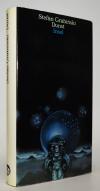 |
Grabinski, Stefan. Dunst und andere unheimliche Geschichten. Mit einem Nachwort von Marek Wydmuch. 1. Aufl. Frankfurt (am Main), Insel-Verlag 1974. Gr.-8°. 244 S. OPbd. mit farb. illustr. OU. (Bibliothek des Hauses Usher).
Erste Ausgabe. – Umschlagkanten minimal berieben, Unterschnitt gest., N. u. St. a V., sehr gutes Exemplar. Schlagwörter: Fantasie, Fantasy, Phantasie, Phantastik / Utopie |
30,-- |  |
 |
Grabinski, Stefan. Dunst und andere unheimliche Geschichten. Mit einem Nachwort von Marek Wydmuch. 1. Aufl. Frankfurt (am Main), Insel-Verlag 1974. Gr.-8°. 244 S. OPbd. mit farb. illustr. OU. (Bibliothek des Hauses Usher).
Erste Ausgabe. – Eintrag a. V. u. T., sehr gutes Exemplar. Schlagwörter: Fantasie, Fantasy, Phantasie, Phantastik / Utopie |
35,-- |  |
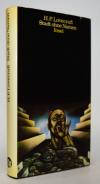 |
Lovecraft, H. P. Stadt ohne Namen. Horrorgeschichten. [1. Aufl.]. Frankfurt (am Main), Insel-Verlag 1973. Gr.-8°. 247 S. OPbd. mit farb. illlustr. OU. (Bibliothek des Hauses Usher).
Erste Ausgabe. – Umschlag an den Kanten leicht berieben und mit 3 kl. (davon 2 geklebten) Randläsuren, sonst gutes Exemplar. Schlagwörter: Fantastik, Fantasy, Phantasie, Phantastik / Utopie |
50,-- |  |
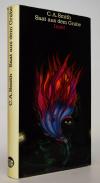 |
Smith, Clark Ashton. Saat aus dem Grabe. Phantastische Geschichten. Deutsch von Friedrich Polakovics. Frankfurt am Main, Insel-Verlag 1970. Gr.-8°. 216 S. OPbd. mit farb. illustr. OU. (Bibliothek des Hauses Usher, hrsg. Kalju Kirde).
Erste Ausgabe. – Eintrag a. V., Folienkaschierung des Umschlags an den Kanten minimal angelöst, sonst sehr gut erhalten. Schlagwörter: Fantasie, Fantasy, Phantasie, Phantastik / Utopie |
30,-- |  |
| Bechstein, Ludwig u. V. Kleinknecht. Album der Haupt- und Residenzstädte Europa’s. I. (und) II. Band. (2. Aufl.). 10 Teile in 1 Band. Schweinfurt, Kleinknecht’ Kunstverlag 1846. 8°. Getrennte Paginierung mit 10 Ansichten und 10 Stadtplänen in Stahlstich. Hldr. d. Zt. mit Romantikervergoldung.
Engelmann 273. – Stadtbeschreibungen von: Berlin, Wien, Dresden, Leipzig, Paris, Weimar, München, Bremen, Frankfurt und Prag. Jeder Teil mit einer Gesamtansicht in Stahlstich sowie einem Stadtplan der – außer bei Paris – von kleinen Detailansichten umgeben ist. – Komplett mit allen Teilen selten. – Rücken und Kanten etwas berieben, Drucktitel von Band I fehlt, die Tafeln im Rand etwas braunfleckig, gutes dekorativ gebundenes Exemplar. Schlagwörter: Ansichten, Ansichtenwerke, Geographie |
320,-- |  |
|
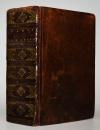 |
Plautus, (Titus) Maccius. Comoediae. Accedit commentarivs ex variorum notis & observationibus, ex recensione Ioh. Frederici Gronovii. Amsterdam, Ex Typographia Blaviana 1664. 8°. Gestoch. illustr. Titel, [6] Bl., 1154 S., [26] Bl., [24] Bl. Ldr. der Zeit mit goldgepr. Rückenschild und dekorativer Rückenvergoldung.
Ebert II, 17204. Graesse V, 329. NDB VII, 127 f. Schweiger II, 766. – Erste Ausgabe dieser Bearbeitung. – Der niederl. Philologe J. F. Gronow (lat. Gronovius, 1611-1671) „ist einer der bedeutendsten Latinisten des 17. Jahrhunderts; abgesehen von seinen „Observationum libri III“ … sind seine meist kommentierten Ausgaben bahnbrechend geworden“ (G. Baader in NDB). – T. M. Plautus (etwa 250 bis 184 v. Chr.) war „der bedeutendste römische Lustspieldichter. Von seinen Komödien sind 21 erhalten, die ältesten vollständig überlieferten Bühnenstücke der lateinischen Literatur; die bekanntesten sind: Amphitruo; Apulularia (die Topfkomödie), Captivi (die Gefangenen), Menaechmi (die Zwillinge), Miles gloriosus (der renommierende Offizier), Mostellaria (die Gespensterkomödie), Trinummus (der Schatz). … Genial ist P. in der wundervollen Frische, kraftvollen Ausdrucksfähigkeit und Beweglichkeit der Sprache, vor allem in der Gesangslyrik. Seine Wirkung in Mittelalter und Neuzeit war groß; Shakespeare, Molière, Holberg, Gryphius, Lenz, Heinrich v. Kleist u. a. wurden durch ihn angeregt“ (Tusculum-Lexikon). – Einband geringfügig berieben, zeitgenöss. Besitzvermerk auf dem Titel, stellenweise etwas wasserfleckig und gebräunt, gutes dekorartiv gebundenes Exemplar. Schlagwörter: Altphilologie, Komödie, Komödien, Literatur, Theater, Theaterstücke |
240,-- |  |
 |
Duplessi-Bertaux, J(ean). Album de la jeunesse, des amateurs, et des artistes composé de vingt-cinq sujets divers, arts et métiers, chevaux, chasses, scènes militaires, vues et paysages ornés de fabriques et d’animaux etc. Dessinés et gravés à l’eau-forte par feu J. Duplessi-Bertaux. Précédé du portrait de l’auteur et d’une notice historique sur les petits-maitres Callot, La Belle et Sébastien Leclerc. Présenté à S. A. Royale Monseigneur le Duc de Bordeaux par (Jean-Francois) Joubert. Paris, J. Didot aine pour Joubert 1823. Quer-4°. [1] Bl., 16 S., [1] Bl., 1 gestoch. Portrait u. 25 mont. Kaltnadel-Radierungen auf China. Weinroter Maroquinlederband der Zeit mit blindgepr. Rücken- und Deckelornamentik, blindgepr. Wappen-Supralibros des franz. Königs Charles X und Goldschnitt.
Benezit IV, 32. Quérard II, 704. – Erste Ausgabe. – Vorzugsausgabe auf Vélin. Mit zeittypischen Illustrationen des bedeutenden franz. Malers, Zeichners und Radierers Jean Duplessi-Bertaux (auch J. Duplessis-Bertaux, 1747-1820); darunter sieben Berufsdarstellungen (Straßenbau, Werkstatt für Kochgeschirr, Frisör, Maurer, Fabrikation von Dachziegeln, Hufschmied und Hutgeschäft). Die anderen Tafeln zeigen einen Hütchen-Spieler, Jagdszenen, Schüler des Lycée Royal und ein Mädchen-Pensionat, außerdem eine Feldküche und weitere militärische Szenen, darunter die Schlacht bei Waterloo. – Prachtvoll gebundenes Exemplar aus der Bibliothek von Charles-Philippe de France (1757-1836), der 1824 als Charles X. und Nachfolger seines Bruders Ludwig XVIII. den französischen Tron bestieg. – Kapital unauffällig restauriert, Gelenke etwas berieben, Textblätter im Rand und Trägerpapier teils leicht braunfleckig, schönes prachtvoll gebundenes Exemplar. – Provenienz: Collection Hubert Guerrand-Hermès, autour de la Duchesse de Berry, 15. 12. 2023 Sotheby’s, Paris. Schlagwörter: Einbände, Französische Kinderbücher, Vorzugsausgaben |
1.600,-- |  |
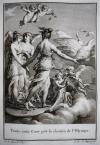 |
La Fontaine, Jean de. Les amours de Psyché et de Cupidon, avec le poème d’Adonis. Paris, (Pierre Francois) Didot le Jeune (pour Saugrain) L’An troisième (1795). 4° (30 x 23 cm.). [4] Bl., 234 (recte 240) S. mit gestoch. Portrait von (Pierre) Audouin nach Hiacinte (Francois) Rigault und 8 Kupfertafeln von Jean Dambrun, A. B. Duhamel, Jean-Baptiste Michel Dupréel, Emmanuel Jean Nepomucène de Ghendt, Louis Michel Halbou, Jaques-Louis Petit u. Jean Baptiste Simonet nach (Jean-Michel) Moreau le Jeune. Kalbsledereinband der Zeit mit goldgepr. Rückenschild, dekorativer Rückenvergoldung und goldgepr. Deckelfiletten.
Brunet III, 762. Cohen-Ricci Sp. 583. Lewine S. 283. Ray 120. Rochambeau, Psyché 24. Sander 1036. Tchemerzine, VI, 396. – Erste Ausgabe mit den Illustrationen von J.-M. Moreau (1741-1814), der zu den bedeutendsten Illustratoren des französischen Rokoko gehört. Sehr schöner Druck in der Tradition der klassischen Pressen (Baskerville u. Bodoni) auf Velin-Papier in prächtiger Didot-Typographie. – Rücken am Fuß leicht beschädigt, Ecken bestoßen, meist nur im Blattrand etwas braunfleckig, gutes dekorativ gebundenes Exemplar. Schlagwörter: Einbände, Illustrated books, Illustrierte Bücher |
1.000,-- |  |
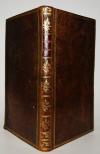 |
Monge, Gaspard. Traité élémentaire de Statique. Deuxième édition. Paris, Pougin An III (1795). 8°. [2] Bl., 188 S. u. 5 gefalt. Kupfertafeln. Marmorierter Kalbslederband der Zeit mit goldgepr. Rückenschild, floraler Rückenvergoldung und goldgepr. Deckelfiletten.
DSB IX, 477. Poggendorff II, 188. – Erschien zuerst 1787. – Der bedeutende franz. Mathematiker G. Monge (1746-1818) war seit 1768 Professor für Mathematik und Physik in Paris. „M. gilt heute, obwohl er auf beiden Gebieten viele Vorläufer hatte, als eigentlicher Begründer der darstellenden und der Differentialgeometrie und auch als wesentlicher Anreger der projektiven Geometrie, die von seinen Schülern L. N. M. CARNOT, PONCELET, C.-J. BRIANCHON u. a. ausgebaut wurde“ (P. Schreiber in Lexikon bedeutender Mathematiker). – Textteil im oberen Blattrand etwas sporfleckig, die ersten drei Tafeln etwas wasserrandig, schönes sehr dekorativ gebundenes Exemplar. Schlagwörter: Mathematics, Mathematik, Physics, Physik, Statik, Statistics |
180,-- |  |
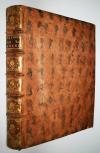 |
Dupin, Pierre. Traité des peines des secondes nôces. Dans lequel on voit de quelle maniere les peines des secondes nôces son observées, tant dans les provinces du droit écrit, que dans la France coûtumiere… Paris, Denis Mouchet et Durand 1743. 4°. XII, 535, (1) S. mit Buchschmuck in Holzschnitt. Kalbslederband der Zeit mit goldgepr. Rückenschild und floraler Rückenvergoldung.
Erste Ausgabe. – Interessante juristische Abhandlung über die Wiederverheiratung von Wittwen und Wittwern und die zivilrechtliche Behandlung der Kinder aus der ersten Ehe. – P. Dupin (1690-1751) war Staatsanwalt in Bordeaux. – Stellenweise etwas gebräunt und leicht braunfleckig, schönes dekorativ gebundenes Exemplar. Schlagwörter: Ehe, Frankreich, Gewohnheitsrecht, Kulturgeschichte, Scheidung, Strafrecht, Zivilrecht |
240,-- |  |
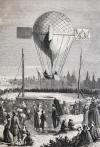 |
Das neue Buch der Erfindungen, Gewerbe und Industrien. Rundschau auf allen Gebieten der gewerblichen Arbeit. Hrsg. in Verbindung mit E. Bobrik, C. Böttger, R. Glass, Fr. Kohl u. a. Pracht-Ausgabe. 6 Bände. Leipzig u. Berlin, Otto Spamer 1864-1867. Gr.-8°. Mit je einem getönten Frontispiz, 26 Holzstich-Tafeln sowie zahlreichen teils ganzs. Holzstichen. OHldr. mit goldgepr. Rückentiteln und Linienvergoldung.
5. Auflage des interessanten Kompendiums zur Technikgeschichte des 19. Jahrhunderts; „eher ein neues Werk, als eine wenn auch noch so vollständig umgearbeitete neue Auflage“ (Vorrede). – I. J. Zöllner, O. Mothes und Fr. Luckenbacher, Einführung in die Geschichte der Erfindungen. – II. J. Zöllner, Die Kräfte der Natur und ihre Benutzung. – III. R. Ludwig, R. Glass, H. Wagner und C. Böttger, Die Gewinnung der Rohstoffe. – IV. Fr. Luckenbacher, C. v. H. und K. de Roth, Die chemische Behandlung der Rohstoffe. – V. G. E. Habich, W. Hamm, Fr. Luckenbacher und H. Wagner, Die Chemie des täglichen Lebens. (Darin Aufgußgetränke, Wein, Bier, Färberei etc.). – VI. Fr. Kohl, Fr. Luckenbacher und H. Rentzsch, Die mechanische Bearbeitung der Rohstoffe. – Einbände etwas berieben, stellenweise braunfleckig und gebräunt, gutes Exemplar. Schlagwörter: Eisenbahn, Erfindungen, Kunstgewerbe, Kunsthandwerk, Schifffahrt, Spamer-Verlag |
140,-- |  |
 |
Lundahl, B. Tabak ist Gift! Physischer und psychischer Einfluß des Tabaks auf den menschlichen Organismus. Ergebnisse wissenschaftlicher Forschungen, in verschiedenen Ländern gesammelt. Aus dem Schwedischen. 2. Auflage. Berlin, Theobald Grieben o. J. (1867). 8°. 79, (1) S. Hln. d. Zt.
Stellenweise etwas fleckig und gebräunt, gutes Exemplar. Schlagwörter: Tabak |
30,-- |  |
 |
Nemeth, Susanna. Neues vollständiges und geprüftes Kochbuch. Eine Sammlung von tausend Vorschriften zur Bereitung der besten, nahrhaftesten und schmackhaftesten Speisen, als Suppen, Ragouts, Gemüse, Eingemachte, Braten, Fische, Saucen, Gelées, Cremen, Kuchen, Pasteten, Torten, Compots, Gefrornen, Getränken, eingemschten Früchten und aller Arten Desserts auf die einfachste und wohlfeilste Art. Nach vieljähriger Erfahrung herausgegeben. 3. Aufl. Leipzig, Georg Wigand 1836. 8°. XV, (1), 242 S. Hln. d. Zt.
Weiss 2700 (kennt nur Ausg. Pest, Heckenast). – Mit genau 1000 Rezepten. – Deckel etwas berieben, durchgehend etwas braunfleckig, gutes Exemplar. Schlagwörter: Kochbücher |
140,-- |  |
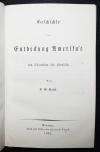 |
Kohl, J(ohann) G(eorg). Geschichte der Entdeckung Amerika’s von Columbus bis Franklin. Bremen, Heinrich Strack 1861. 8°. 454 S. OLn. mit goldgepr. Rückentitel u. Linienvergoldung.
ADB XVI, 425. Howes K 245. Sabin 38213. – Erste Ausgabe. – Der bedeutende Reiseschriftsteller J. G. Kohl (1808-1878) hielt sich 1854 bis 1858 in den USA auf. „Besonders interessirte K. die Entdeckungsgeschichte der Neuen Welt, und mit einem für den einzelnen Mann ungeheuren Aufwand an Zeit, Mühe und Geld legte er eine umfassende, überaus werthvolle Sammlung aller auf die Entdeckung und den Fortschritt der geographischen Kenntnisse Amerika’s bezüglichen Land- und Seekarten an. Ein große Reihe werthvoller Arbeiten Kohl’s beziehen sich auf die Entdeckungsgeschichte dieses Erdtheils, so „Kritische Erläuterungen zu den beiden ältesten Generalkarten von Amerika aus den Jahren 1527 und 1529“; die „Geschichte der Entdeckung Amerika’s von Columbus bis Franklin“, weiter die im Auftrage der U. S. Court Survey Office abgefaßte „History of the East Coast of Northamerica particulary the Coast of Maine“. With 22 maps (1869) und eine „Geschichte des Golfstromes und seiner Erforschung“ (1868).“ (W. Wolkenhauer in ADB). – Vorderes Gelenk geringfügig angeplatzt, sehr gutes Exemplar. Schlagwörter: Americana, Amerika, Geschichte |
120,-- |  |
 |
(Rickman, John). Troisième voyage de Cook ou Journal d’une expédition faite dans la mer Pacifique du sud et du nord. En 1776, 1777, 1778, 1779 & 1780. Traduit de l’anglois (par Jean-Nicolas Démeunier). Paris, Pissot, pere & fils et Laporte 1782. 8°. X, 508 S. mit gestoch. gefalt. Frontispiz u. 1 gefalt. gestoch. Karte. Kalbslederband der Zeit mit goldgepr. Rückenschild und floraler Rückenvergoldung.
Cox I, 65. Henze I, 643 ff. Sabin 16261. – Oktavausgabe der französischen Übersetzung der Beschreibung von Cooks dritter und letzter Reise, die auf Hawaii mit seinem Tod endete. – „This expedition included the Pacific coast from Nootka to the extreme North. The British claim to Nootka was based upon the fact that Cook was its discoverer, and that by this right it belonged to England“ (Cowan 54). – Vorderes Gelenk im oberen Drittel eingerissen, nur vereinzelt leicht braunfleckig, gutes dekorativ gebundenes Exemplar. Schlagwörter: Americana, Amerika, Arctic Ocean, Discovery and exploration, Entdeckungsreisen, Nord-Ouest, Passage du, North America, Northwest Coast of North America, Northwest Passage, Reiseberichte, Reisebeschreibungen, Voyages around the world, Voyages autour du monde, Weltreise |
320,-- |  |
 |
(Grimm, Jakob u. Wilhelm). Sieben Märchen nach Brüder Grimm. (Deckeltitel). (Sammelband der Märchen-Bilderbücher Nr. 1-7). Mainz, Scholz o. J. (1905). Quer-8°. 56 unbez. Bl. mit 7 wdh. farb. illustr. Titeln (zwei Zwerge mit Pflaumenbäumen, Entwurf von J. Diez), 56 farbalgraphierten Farbtafeln (von dünnen Aluminiumplatten gedruckt) u. Illustrationen im Text. Farbig illustr. OLn. (von Franz Jüttner). (″Das deutsche Bilderbuch“. Serie A: Märchen Nr. 1-7, Nr. 103).
Klotz 9000/82. Doderer-Müller S. 257 ff. (mit Abb.). Ries, Scholz S. 138. Wegehaupt, Grimm S. 37 f. (mit Abb.). – Seltener Sammelband mit den sieben ersten Titeln der bekannten Märchen-Bilderbuch-Reihe des Scholz-Verlags; sogenannte „Prachtausgabe“. – Mit den von Julius Diez entworfenen Vorsätzen: Motiv „Paradiesvogel“. – Enthält die Märchen: Dornröschen mit Bildern von Julius Diez; Marienkind mit Bildern von Heinrich Lefler und Joseph Urban; Aschenputtel mit Bildern von Adolf Münzer; Rotkäppchen mit Bildern von Arpad Schmidhammer; Hänsel und Gretel mit Bildern von Richard Scholz; Sneewittchen mit Bildern von Franz Jüttner; Frau Holle mit Bildern von Fritz Kunz. – Vorliegender umfangreichster Sammelband der Reihe enthält auch die beiden bedeutendsten künstlerischen Beiträge „Das Marienkind“ der Wiener Künstler Lefler und Urban (vgl. Bilderwelt 466) sowie „Frau Holle“ des Schweizers Fritz Kunz (1868-1947, vgl. SBI S. 48 mit Abb. Tafel 6), „dessen festlich-dekorative und symbolistische Note in der ganzen Reihe hervorsticht“ (H. Ries). – Im Falz zwischen den Titeln teils geringfügig angeplatzt, papierbedingt gebräunt, sehr gutes Exemplar. Schlagwörter: Jugendstil, Märchenbilderbücher, Scholz |
600,-- |  |
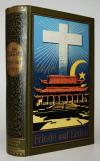 |
May, Karl. Und Friede auf Erden. Reiseerzählung. 66.-72. Tsd. Radebeul, Karl-May-Verlag o. J. (1938). 8°. 552 S. Farbig illustr. OLn. (Gesammelte Werke, Band 30).
Hermesmeier/Schmatz GW 30.11. – „Es zeugt im Nachhinein von nicht geringem Mut, dass Schmid diesen Band nicht aus dem Programm nahm, sondern sogar noch sechs Jahre nach der Machtergreifung eine Neuauflage in Auftrag gab. Davon wurde zunächst nur die Hälfte aufgebunden. Der Rest fiel durch die Bombenangriffe zum größten Teil der Vernichtung anheim“ (Hermesmeier/Schmatz S. 178). – Außergewöhnlich schönes und sauberes Exemplar. Schlagwörter: Abenteuer |
60,-- |  |
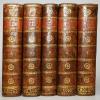 |
Marmontel, (Jean François). Contes moraux. (Suivis) Nouveaux contes moraux. 10 Teile in 5 Bänden. Paris, Richard Caille et Ravier „An IX“ (1800-1801). Kl.-8° (13,5 x 9 cm.). Mit 10 gestoch. Frontisp. Kalbslederbände der Zeit mit goldgepr. Rückensch. und dekorativer Rückenvergoldung.
Hübsch gebundene Taschenausgabe der höchst unmoralischen und daher auch höchst erfolgreichen, zunächst im Mercure veröffentlichten Contes moraux des bedeutenden französischen Schriftstellers Jean-François Marmontel (1723-1799). – Schönes dekorativ gebundenes Exemplar. Schlagwörter: Erotica, Illustrated books, Illustrierte Bücher |
200,-- |  |
 |
Rose, William Stewart. Partenopex de Blois, a Romance in four cantos. Freely translated from the french of Le Grand, with notes. (And): Ders. The Crusade of St. Lewis, and King Edward the Martyr. 2 Werke in 1 Band. London, James Ballantyne, Edinburgh für Longman, Hurst, Rees, and Orme 1807 u. 1807. 4°. VII, 225 S. mit 3 Kupfertafeln u. 3 gestoch. Vignetten nach Richard Smirke; [2] Bl., 31 S. Kalbslederband der Zeit mit goldgepr. Rückentitel, reicher Rücken- und Deckelvergoldung, Innenkantenvergoldung und Goldschnitt in modernem Schuber.
Erste Ausgaben. – William Stewart Rose (1775—1843) „was a British poet, translator and Member of Parliament, who held Government offices.From a Tory background, he was well-connected in the political and literary world, and made a mark by his championing of Italian poets and a burlesque style of verse based on their influence as satirists“ (Wikipedia). – Richard Smirke (1778-1815) „studied painting in the schools of the Royal Academy, where in 1799 he gained the gold medal with a picture of Samson and Delilah. But his tastes led him to the study of ancient works of art and historical costume, and he became a highly skillful antiquarian draughtsman. When the wall paintings in St. Stephen’s Chapel, Westminster, were discovered in 1800, Smirke made a set of facsimile copies of them in watercolours, on a small scale, which are now in the possession of the Society of Antiquaries; he was afterwards employed by the society on similar work. He gave much time to the study of chemistry, and made some discoveries in the qualities of colour. He died at the Howard Arms Inn“ (Wikipedia). – Rücken restauriert, Gelenke berieben, gestoch. Wappen-Exlibris, nur im äußeren Blattrand etwas braunfleckig, gutes prachtvoll gebundenes Exemplar. Schlagwörter: Einbände, Illustrated books, Illustrierte Bücher |
220,-- |  |
 |
Pasteur – Vallery-Radot, René. La vie de Pasteur. Quatorzième édition. Paris, Hachette et Cie. 1912. Gr.-8°. [2] Bl., 692 S. mit 1 Portrait in Heliogravure nach einer Fotografie von P(aul) Nadar. Hldr. d. Zt. mit dekorativer Rückenvergoldung und Kopfgoldschnitt (Orig.-Umschlag beigebunden).
Dekorativ gebundenes Exemplar der wichtigsten Biographie des großen franz. Chemikers. – Sehr gut erhalten. Schlagwörter: Biographie, Chemie |
90,-- |  |
 |
Oesterreicher, (Johann) H(einrich). Dr. H. Oesterreicher’s anatomischer Atlas oder bildliche Darstellung des menschlichen Körpers. Neu bearbeitet mit 46 neuen Tafeln und mehr als 200 Figuren vermehrt… von M(ichael) Erdl. 2., verb. Aufl. München, Joh(ann) Palm 1852. Imperial-Folio (54 x 43 cm.). 308 S. mit 180 (32 beikol.) lithogr. Tafeln. Hldr. d. Zt. mit goldgepr. Rückenschild u. Linienvergoldung.
Hirsch-Hüb. IV, 415. – Ohne den Textband (116 S., 8°). – Der umfangreiche, nach Format und Inhalt gewaltige Atlas der menschlichen Anatomie steht in der Tradition des späten 18. und frühen 19. Jahrhunderts und entspricht damit ungefähr dem Vorhaben Loders. Ein Teil der Tafeln, knapp 90, und diverse im Umriss hatte J. H. Oesterreicher (1802-1843, Anatom an der Landshuter Chirurgenschule) ab ca. 1825 selbst gezeichnet und in Stein „geschnitten“, d.h. graviert; sie wurden 1830 in München als „anatomische Steinstiche….“ veröffentlicht. Um 1840 gingen die Steinplatten in den Besitz der Palm’schen Buchhandlung über und diese Firma betraute einen der ersten Anatomen der Münchener Universität, M. Erdl (1815-1848), mit der Überarbeitung, Korrektur und Vervollständigung des Werkes. Es entstanden viele neue Tafeln, andere wurden ergänzt; dazu wurden fast alle Umrisstafeln neu geschaffen und einer modernen Systematik angepasst. Die äusserst detaillierten Darstellungen zeigen: Die Knochenlehre (17 Tafeln), Bänderlehre (8), Eingeweide- (25), Muskel- (10), Gefäss- (68) und Nervenlehre (52). – Deckel und Kanten etwas berieben, Titel und alle Tafeln im unteren Rand mit Stempel einer Schulbibliothek, nur vereinzelt etwas fleckig, gutes dekorativ gebundenes Exemplar. Schlagwörter: Anatomie |
1.200,-- |  |
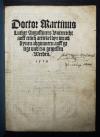 |
Luther, Martin. Unterricht auff etlich artickel dye im vo(n) seynen abgunnern auff gelegt und tzu gemessen werden. O. Dr. u. O. (Leipzig, Melchior Lotter d. Ä.) 1519. 8°. [4] Bl. Moderner Papierumschlag.
Benzing 295. VD 16: L 6838. – Einer von drei Drucken der ersten Ausgabe; erschien im selben Jahr mit leicht abweichendem Titel auch bei Wolfgang Stöckel und Martin Landsberg in Leipzig. – „1518 wurde der päpstliche Kammerherr Karl von Miltitz als Nuntius nach Sachsen gesandt, um ein Stillhalteabkommen mit Luther auszuhandeln und Kurfürst Friedrich den Weisen, dem Miltitz als Ehrengabe Leos X. die Goldene Tugendrose überreichte, davon abzubringen, Luther weiterhin zu schützen. Im Januar 1519 hatte Miltitz mit Luther eine Unterredung in Altenburg, bei der dieser ihm weitreichende Zusagen machte, die er u. a. mit seiner Schrift Unterricht auf etliche Artikel vom Februar 1519 einlöste. In der Schrift, die nur aus wenigen Blättern besteht und die er in Briefen an Freunde als seine „Apologie“ bezeichnete, will Luther „schädlichen Zungen begegnen“, durch welche er dem einfältigen Volk in gewissen Artikeln fälschlich verdächtig gemacht worden sei, nämlich in betreff der Artikel „von der lieben Heiligen Fürbitt, vom Fegfeuer, von dem Ablass, von den Geboten der heiligen Kirche, von den guten Werken, von der römischen Kirche“. Luther bekennt sich hier noch zur katholischen Lehre. So billigt er die Anrufung der Heiligen, ja er hält es sogar für eine Tatsache, dass Gott an ihren Leichnamen und Gräbern Wunder bewirkt. Am Fegefeuer hält er ebenfalls fest und daran, dass man den Seelen im Fegefeuer mit Gebet und Almosen helfen kann. Allerdings lasse sich nicht mit dem Ablass in Gottes Gericht eingreifen. Den Ablass lässt Luther als eine Entledigung der für die Sünde auferlegten Genugtuung gelten, setzt ihn aber auch jetzt weit unter die von Gott gebotenen guten Werke. Man dürfe aber nicht auf die guten Werke als Verdienst bauen, sondern allein auf Gottes Gnade. Kirchliche Vorschriften, wie das Fastengebot, stehen zum Gebot Gottes und den ewigen Sittengesetzen wie Stroh zu Gold und Luther erhofft sich von einem Konzil die Abmilderung der kirchlichen Vorschriften. Die römische Kirche, in welcher Petrus und Paulus und Tausende von Märtyrern ihr Blut vergossen haben, sei von Gott vor allen andern geehrt und trotz ihrer gegenwärtigen Mängel solle man sich nicht von ihr abwenden. Wie weit aber die päpstliche Gewalt reiche, solle man die Gelehrten ausfechten lassen, denn für der Seelen Seligkeit habe die päpstliche Gewalt keine Bedeutung, da Christus seine Kirche nicht auf äußere Gewalt oder irgendwelche zeitliche Dinge, sondern auf Liebe, Demut und Einigkeit gegründet habe“ (J. Köstlin, Luther, sein Leben und seine Schriften III, 243 f.). – Besitzvermerk aus dem 19. Jahrhundert auf dem Titel „Joh(ann) Heinr(ich) Wohlers Hamburg 1840“ (vermutlich der Hamburger Missionar J. F. H. Wohlers 1811-1885), durchgehend mit kl. Wurmspuren und etwas fleckig, sonst gut erhalten. Schlagwörter: Flugschrift, Kirchengeschichte, Reformation, Theologie, Theology |
1.400,-- |  |
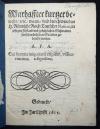 |
Warhaffter kurtzer bericht, wie, wann vnd durch wen das H. Römische Reich, Teutscher Nation, in jetzigen Zustand vnd gefahrliches Mißtrawen zwischen desselben Ständen gebracht worden. A. P. A. O. O. u. Dr. 1615. 8°. [1] Bl., 44 S. Moderner Papierumschlag.
VD17 23:280458C. – Sehr seltene Flugschrift über die politischen Zustände vor dem Dreissigjährigen Krieg. Mit dem Zitat auf dem Titelblatt „Cui licentia iniquitatis eripitur, utiliter vincitur. Augustinus“. Es ist auch ein zweiter Druck der Flugschrift bekannt, hier endet das Zitat mit „… vincitur. Aug.“ (VD17 14:002333Z). – Durchgehend etwas gebräunt, gutes Exemplar. Schlagwörter: Dreissigjähriger Krieg, Flugschrift |
400,-- |  |
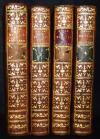 |
Rousseau, J(ean)-J(acques). Émile, ou, De l’éducation. 4 Bände. Amsterdam, Jean Néaulme (d. i. Paris, N.-B. Duchesne) 1762. Kl.-8°. [2] Bl., VIII, 466 S.; [2] Bl., 407, (1) S.; [2] Bl., 381, (1) S.; [2] Bl., 455, (1) S. mit Titeln in Rot u. Schwarz u. 5 Kupfertafeln von Longueil, Pasquier u. Le Grand nach Eisen, davon 4 als Frontispiz. Kalbslederbände der Zeit mit goldgepr. Rückensch., floraler Rückenvergoldung und Rotschnitt.
Slg. Borst 124. Cohen 903. Dufour I, 190. McEachern, L’edition originale de l’Emile, Bulletin du bibliophile, 1987, S. 20 ff. Sander 1747. – Zweiter Druck der ersten Ausgabe; der erste Druck erschien mit der Ortsangabe „La Haye“ (Den Haag). – „Mit diesem aus fünf Büchern bestehenden psychologischen Roman, Summe und Gipfel seines Denkens, erganzt Rousseau die in seinen früheren Werken dargelegte These, dass der Mensch von Natur gut und nur von Zivilisation und Gesellschaft korrumpiert sei“ (KLL II, 2034). – Einbände etwas berieben, Deckel teils mit geringf. Wurmspuren, nur vereinzelt schwach braunfleckig, gutes dekorativ gebundenes Exemplar. Schlagwörter: Illustrated books, Illustrierte Bücher, Pädagogik, Philosophie |
600,-- |  |
 |
(Stürmer, Margit). Hundertwasser Kunstbauwerke in Österreich. Photographiert von Gregor Semrad. Wien, H. B. Medienverlag (2004). Quer-4°. 128 S. mit zahlr. farb. Abb. Farbig illustr. OPbd. mit farbig illustr. OU.
Sehr gutes Exemplar. Schlagwörter: Austriaca, Kunst, Österreich |
40,-- |  |
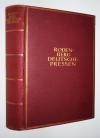 |
Rodenberg, Julius. Deutsche Pressen. Eine Bibliographie. Mit vielen Schriftproben. Zürich, Wien, Leipzig, Amalthea-Verlag (1925). Gr.-8°. 550 S., [13] Bl. mit 51 Tafeln. OLn. mit goldgepr. Rücken- u. Deckeltitel.
Erste Ausgabe. – Gutes Exemplar des Standardwerks. Schlagwörter: Bibliographie, Pressendrucke |
50,-- |  |
 |
Album (Deckeltitel). O. O., Dr. u. J. um 1860. Quer-12° (8,3 x 12,5 cm.). 14 handkol. lithogr. Tafeln mit Tonplatte. OPbd. mit Deckelvergoldung.
Wohl aus einem Bilderbogen hergestelltes Miniatur-Bilderbuch. Die erste Tafel in der oberen rechten Ecke mit der Verlagsnummer 648. – Zeittypische Kinderszenen Entenjagd, Puppenspiel, Seifenblasen etc. – Die Tafelrückseiten mit handschriftl. englischen Stammbuch-Versen. – Gelenke und Kanten etwas berieben, die Tafeln im Rand etwas braunfleckig, sonst gut erhalten. Schlagwörter: Biedermeier, Bilderbogen |
240,-- |  |
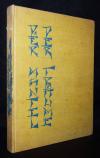 |
Balázs, Béla (d. i. Herbert Bauer). Der Mantel der Träume. Chinesische Novellen. Mit 20 Bildern von Mariette Lydis. München, D. & R. Bischoff 1922. 4°. 110 S. mit 20 mont. Farbtafeln. OLn.
LKJ IV, 25 f. – Erste Ausgabe. – „Beeinflußt von Auffassungen des Symbolismus (M. Maeterlinck) beschäftigte er sich mit ungarischen sowie chinesischen und indischen Märchen, in denen er die künstlerische Chiffre einer tieferen kosmischen Wahrheit, den symbolischen Sinn des gesamten menschlichen Lebens, sah. Es entstanden … die Märchenbände „Hét mess kner izidor kiadása“ (1917; dt. Sieben Märchen, 1921) und „Der Mantel der Träume“ (1922)“ (B. Dolle in LKJ). – M. Lydis (1887-1970) „war Illustratorin, Malerin, Grafikerin, Schriftstellerin, Dichterin, Aquarellistin, Litografin und Portraitistin. Die Stilpluralistin trat als 28-Jährige erstmals mit Federzeichnungen und Linolschnitten öffentlich in Erscheinung. Sie illustrierte Bücher wie z.B. den Koran – ein äußerst ungewöhnliches Unterfangen. Mitte der 20er Jahre publizierte sie ihr „Orientalisches Traumbuch“ mit eigenen Texten. Auffallend ist, dass sie fast ausschließlich Frauen portraitierte, vor allem lesbische Frauen, Prostituierte, Frauen im Gefängnis und in Nervenheilanstalten. Weibliche Erotik und die explizite Darstellung von lesbischer Sexualität standen im Zentrum ihres Werkes“ (S. Reyer in C. Maryska: Mon travail est mon refuge. Die Malerin und Buchillustratorin Mariette Lydis – eine Unbekannte). – Einband etwas angestaubt, sonst gutes sauberes Exemplar. Schlagwörter: Illustrated books, Illustrierte Bücher |
100,-- |  |
 |
Henri – Marcangeli, Catherine (Ed.). Total Artist. (Painter poet musician). London, Occasional Papers (2014). Gr.-8°. 207, (1) S. mit zahlr. teils farb. Abb. Illustr. OKart.
Erste Ausgabe der ersten Monographie über den britischen Maler, Dichter und Musiker A. Henri (1932-2000). – Aus der Bibliothek des Buchkünstlers und Fotografen Jürgen Seuss mit dessen Namenszug auf dem Titel und mit 2 Orig.-Photographien Portraits von A. Henri und Gerold Dommermuth von J. Seuss. – J. Seuss lernte A. Henri 1964 in Liverpool kennen. 1965 gab er zusammen mit G. Dommermuth und Hans Meier das Buch „Beat in Liverpool“ heraus. – A. Henri, Gründer der Poetry-Gruppe „Liverpool Scene“, verfasste zusammen mit Brian Patten und Roger McGough die Anthologie „The Mersey Sound“. Das Liverpooler Dichtertrio hat mit dem Buch den Merseybeat-Zeitgeist der 1960er und 1970er Jahre international bekannt gemacht. – Ein Foto mit leichter Knickspur, sonst gut erhalten. Schlagwörter: Beat-Generation, Kunst, Pop art, Pop-Kultur |
100,-- |  |
 |
Henri, Adrian. Autobiography. London, Jonathan Cape (1971). 8°. 46 S. Illustr. OKart.
Erste Ausgabe. – Gutes Exemplar. Schlagwörter: Autobiografie, Autobiographie |
30,-- |  |
|
Einträge 1–50 von 5006
Zurück · Vor
|
|||

